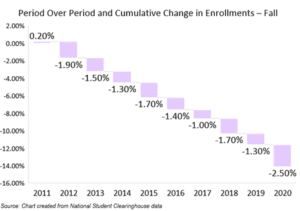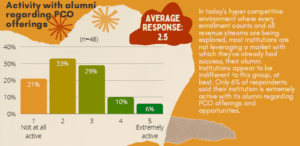[…]
There is, in fact, a “maze” of nearly a million unique education credentials in the United States, the nonprofit Credential Engine reports, including not only degrees but also badges, certificates, licenses, apprenticeships and industry certifications. More have popped up during the pandemic as career-switchers seek education and training.
The result is confusion among employers scrambling for workers — and growing concern that unsavory players may be taking advantage to sell fraudulent credentials.
“What folks are struggling with is whether or not that credential means what it says it means,” said Julie Uranis, vice president for online and strategic initiatives at the University Professional and Continuing Education Association. Read the full article.
Major Updates
- Infrastructure Bill Passes + Build Back Better Act Gets Blocked
President Biden signed the Infrastructure Bill into law in the middle of November, with bipartisan support. The bill contained significant investments in broadband infrastructure and affordability, and ways in which institutions of higher education may receive grants for research or execution of climate change and infrastructure projects, among many other items. At the time of the bills passage, there were also Democratic intraparty promises that the social spending Build Back Better Act would be immediately voted on following the vote on the infrastructure package. That seems all the more unlikely as Democrats were blindsided when Senator Manchin (D-WV) publicly stated he would be voting no on the Build Back Better Act, almost certainly ending the possibility it would pass in short order, and casting into doubt whether Democratic leadership would even bring the bill up for voting at all.
- Negotiated Rulemaking Session at Department of Education Wraps Up, Consensus Not Achieved on Key Issues
In early December, the Department of Education wrapped up its third round and final round of negotiated rulemaking sessions, with 8 out of 12 issues not coming into full consensus on the language within the proposed regulations. Without the committee’s consensus, the Department itself may craft the regulatory language on these issues. A few of the issues that did not achieve consensus included Borrower Defense to Repayment, closed-school loan discharges, loan repayment plans, and Public Service Loan Forgiveness. While we wait to see the proposed final language, the Department is already ramping up for another round of negotiating. A new rulemaking session covering other issues, including Gainful Employment, financial responsibility rules for institutions, and others will be beginning in the new year.
Other News
- Biden extends pause on student loan repayment through May 1 (CNN)
- Congress Allows Online Student Veterans to Keep Full Benefits (Inside Higher Ed)
- Congress Averts Shutdown, Delays Changes to Higher Ed Budget (Inside Higher Ed)
- U.S. Department of Education Announces $182 Million in Education Innovation and Research Grants to Improve Academic Achievement for Underserved Students
The Center for Research and Strategy has recently completed some exciting new research with a few of our corporate partners on different facets of today’s (and tomorrow’s) learners. While each of these efforts provide their own unique benefit, the suite of reports can be leveraged to better inform decision making for institutions moving forward.
Today’s Disengaged Learner is Tomorrow’s Adult Learner – UPCEA and StraighterLine
A shifting economy, uncertainty during the pandemic, and troubles within the higher education landscape are causing more traditional age students to disengage, sit-out, take a gap year, seek alternative forms of education, or go straight to the workforce. This joint study by StraighterLine and UPCEA examines a portion of the student population that disengaged with their institution after previous enrollment. The research focuses on what may have caused students to disengage and what might get them to re-enroll. Participants were asked about their level of engagement with their institution, satisfaction with engagement, likelihood of re-engaging and re-enrolling, and the potential effectiveness of various reengagement strategies.
Understanding the situations and motivations that caused learners to disengage with their institutions is an important way for institutions to be able to be proactive about their engagement with their current students as well as after they leave the institution. Download the full study here.
The Six Personas of the New Learner: Changing Motivations and Situations of the New Learner Landscape – UPCEA and Thinking Cap
The landscape of the economy has changed significantly over the last few decades with technology shaping the delivery of education, the workforce post-graduation, and the value of a degree. Adult learners who are subject to the effects and changes of the evolving digital world are an important section of the higher education ecosystem. This paper looks at the various motivations and drivers of various adult learner segments. Participants were asked about their motivations and reasons for continuing their education, training, and acquiring new skills as well as how schools can best interact with them when communicating these new higher ed opportunities. UPCEA and Thinking Cap Agency partnered to identify the gaps and opportunity areas which institutions can engage and interact with new learners.
The adult learner has changed and continues to evolve. The new adult learner can be challenging as consumers of products and services, including education, but their complexity can provide many opportunities as well. There are also many faces or segments of the adult learner population. To best represent and understand the generational and demographic differences of the respondents, six personas were analyzed and summarized to best represent the new adult learner. Download the full study here.
Supporting & Retaining the New Professional Learner: How continuing education leaders can meet the needs and expectations of today’s learners – UPCEA and Salesforce.org
The higher education landscape is rapidly evolving, and younger generations enrolled in professional, continuing, and online (PCO) programs are consistently increasing. Given these factors, UPCEA and Salesforce.org wanted to gain greater insight into the expectations and experiences of continuing education (CE) students and staff.
This report highlights insights and recommendations for PCO programs at higher education institutions. The key findings reveal learner needs and expectations across the full program lifecycle, the differences between ages and experience levels, and opportunities for institutions to better communicate with, support, and retain students. Additionally, this report examines institutions’ ability to use technology to automate processes and anticipate learners’ needs. Download the full study here.
And look out for more research results from our Marketing survey and Revenue, Budget, Staffing and Outsourcing survey, among others, in 2022!
A Program Planning and Implementation Network Tribute to Gregory Milton, Ph.D.
It is with a heavy heart that we share the news that Greg Milton passed away last week. Greg Milton, Ph.D., was our colleague and friend and PPI’s former Chair (2018). Greg was instrumental to PPI for many years and helped the Network grow by recruiting many members. He was an incredible colleague and very warm-hearted leader who led PPI with compassion, tremendous knowledge in the field of continuing education, and always a smile on his face.
 Greg was a great and innovative leader in higher education and continuing education and held various leadership positions. Since 2019 he has been a Managing Partner for Tarragona Associates, a Higher Education Consulting Group. From 2016 till 2019, Greg was the Director of Academic Programs, School of Extended & International Education, at Sonoma State University.
Greg was a great and innovative leader in higher education and continuing education and held various leadership positions. Since 2019 he has been a Managing Partner for Tarragona Associates, a Higher Education Consulting Group. From 2016 till 2019, Greg was the Director of Academic Programs, School of Extended & International Education, at Sonoma State University.
Greg held a PhD in History from UCLA, an MA in History from The Catholic University of America, and a BA in History from UC Berkeley. He served as an Electronic Warfare Mission Commander, Instructor, Naval Flight Officer from 1989 to 1997. He also served with the United States Naval Academy, U.S. Navy Fleet Air Reconnaissance Squadron Two, U.S. Navy.
With UPCEA Greg led various initiatives and contributed to many committees and conferences. In addition to serving as the PPI Chair in 2018, he participated as the UPCEA West Region Membership Coordinator in 2019/20 and volunteered as a planning committee member at the West Region Conference in 2015 and the 2019 West/Central Region Conference. We will miss Greg greatly.
Two years ago, Google announced that it was launching a career certificate program that would provide all of the essentials to start a new career. The Google Career Certificate programs have exploded on the scene with millions of enrollments and expansion to community colleges.
With lightning speed by higher ed standards, Google has conceived and launched a number of career certificate programs. In just two years, they have gone from concept to credential programs in IT Support, Data Analytics, Project Management, UX Design, and Android Development.
Google advertises that these certificate programs require ten hours of study a week and can be completed in six months:
The IT Support, User Experience Design, Project Management and Data Analytics Certificates cost $39 per month by subscription on Coursera. Access to the Google Associate Android Developer Certification training is free and the official exam fee of $149 is paid to Trueability to administer the exam. Google does not generate any revenue from Google Career Certificates and has made need-based financial assistance available.
Kent Walker, Senior Vice President for Global Affairs at Google said as the plan was announced: “In our own hiring, we will now treat these new career certificates as the equivalent of a four-year degree for related roles.” Google has built a consortium of companies that give preferential treatment to the Career Certificate holders:
The Google Career Certificates Employer Consortium consists of over 150 U.S. companies like Deloitte, Infosys, Snap Inc., Target, Verizon, and of course, Google. These companies span multiple sectors and are committed to considering Google Career Certificate graduates for entry-level jobs. Upon completion of a Google Career Certificate, you will gain access to an exclusive job platform where you can easily apply to opportunities from employers with open jobs. https://grow.google/certificates/it-support/#?modal_active=none
Further, their success rate in advancing careers, as reported by completers, is impressive. “Eighty-two percent of Google IT Support Professional Certificate completers in the U.S. report a positive career outcome like a new job, enhanced skills, promotion, or raise within 6 months.”
“Today, we’re so excited to announce that all of our Google career certificates will be available for free, to every community college in the United States and to every career and technical high school in the United States,” Lisa Gevelber, founder of Grow with Google, tells CNBC Make It. “One of the other things we actually announced today, which I think is super exciting, is that all of our certificates now have been recommended by the American Council on Education to be recognized as college credit for up to 12 credits, which is the equivalent of four college courses at the bachelor’s degree level.”
While the certificate programs are getting the headlines, Google is continuing to develop new artificial intelligence powered applications to make higher ed learning more efficient, accessible and personalized. The AI-tutor program has a variety of applications that are being tested by online universities including Walden and Southern New Hampshire (SNHU).
Head of Education Steven Butschi described the product as an expansion of Student Success Services, Google’s software suite released last year that includes virtual assistants, analytics, enrollment algorithms and other applications for higher ed. He said the new AI tutor platform collects “competency skills graphs” made by educators, then uses AI to generate learning activities, such as short-answer or multiple-choice questions, which students can access on an app. The platform also includes applications that can chat with students, provide coaching for reading comprehension and writing, and advise them on academic course plans based on their prior knowledge, career goals and interests.
“We see a profound shift in education, with new technologies opening up educational opportunities to more people and communities. AI-powered learning solutions will play a key role in this digital transformation, helping institutions, educators and ed-tech companies empower students to learn and achieve more,” LearningMate co-founder Nachiket Paratkar said in a public statement.
What does this all mean for higher education? Certainly, having Google driving tech change and advancement is a huge plus for us. The shot in the arm we get from their advancements will go a long way to promote digital transformation. Notably, the non-profit approach and community college sharing of their career certificates is going to have an impact in advancing careers and workforce preparation.
However, along with these positive impacts driven by Google comes a challenge to the rest of higher education to step up and make programs affordable, efficient, and relevant. To the prospective student, our old semester tuition-based models may not compare well to $39 a month for six months to gain a credential that 150 major companies are considering the benchmark for entry-level employment.
How is your university responding to the challenge? Are you informing institutional leaders of these changes and ramifications? Are you initiating the discussion of how your university should respond to better serve your students?
This article was originally published in Inside Higher Ed’s Transforming Teaching + Learning blog.
Senior administrators ranked persistence and retention as the No. 1 priority in supporting higher education students in a study conducted by American University and the Association of American Colleges and Universities this past spring.
They understand well the challenges facing those who attend their institutions, including the COVID-19 pandemic’s impact. But there are a number of other reasons why students are electing to walk away from their colleges, effectively leaving credits on the table and abandoning their dreams of completion.
The nonprofit University Professional and Continuing Education Association (UPCEA) and online education provider StraighterLine recently released a report that shows that students not only are disengaging because of financial reasons and family commitments, but some are stopping out because they are dissatisfied with higher education altogether. For Gen Z students who stop out, those numbers are high, at 43%.
“Given the pandemic and the evolution of a new economy, one that relies on automation and information, students will be more likely to disengage with higher education for a variety of reasons,” said Jim Fong, Chief Research Officer and Director of the Center for Research and Strategy at UPCEA. “Families are more financially fragile and students have greater challenges. If we don’t act or anticipate this, they’ll not only disengage, but they will become disenfranchised with higher education.”
Demographics show that our society will become more diverse. Students in the future will not only be more diverse by nature, but also by situation. This might mean they have to balance work and family with education or that they have previously disengaged with a college.
Over the past decade, colleges and universities struggled, yet the warning bells went largely unheeded. The National Student Clearinghouse (NSC) shows that higher education lost 2.7 million participants between 2010 and 2020. While some of this can be attributed to the recent effects of the pandemic and the declining number of college-aged students, other factors and causes are at play such as rising tuition, concern regarding job placement, perceived lower return on investment and less favorable household finances.

Higher education needs to work harder for every enrollment … and not just the traditional 18 to 22 year-old college student. They need to reverse a troubling downward trend that is being compounded by employers taking more control and responsibility for training their own workforce and becoming less dependent on higher education to do so.
Every enrollment must be fought for to make up for these losses and the previously ignored or under-valued potential students include:
The Adult or Part-Time Learner or Transfer Student: Of the 18 million students enrolled during the Fall of 2020 [i], just over one third were part-time learners. A similar percentage and number of part-time learners were enrolled during the Spring of 2021 [ii]. Higher education institutions need to market to and engage these credit-carrying students differently from the 18 to 22 year-old learner. This group has different motivations and goals. In 2021, UPCEA and Thinking Cap Agency recently completed a study of the many faces of the adult or part-time learner [iii]. Programs will have to be more accessible, stackable, flexible and relevant to attract these learners.
The Disengaged Learner: The pandemic drove many students from the classroom to the sidelines. Many of these former students question the quality of the education they are receiving, as well as whether or not it will adequately prepare them for a new and more automated economy. In 2021, UPCEA and StraighterLine conducted an analysis [iv] of disengaged learners and found that they leave college for many reasons. The report also identifies opportunities for higher education to reconnect and engage these otherwise lost learners. No longer can colleges and universities treat these students as “not good enough” for their institution. Institutions are going to need a quicker and better response when students disengage and genuinely invite them back to the institution, but through different channels and with greater support. Degree-completion and stackable credentials could also make a degree a more reachable goal for this learner.
Young Men: While young women look at higher education as a means to achieve equitable pay with men, the National Student Clearinghouse and the New York Times [v] identified that men view education very differently. Young men are less confident about whether or not the investment in time and money will yield a strong salary and high likelihood of employment in a future economy that may be evolving at a faster pace than higher education. Higher education will need to rethink its curriculum and communications to attract and retain young men in the future. If they continue to disengage with higher education in favor of immediate higher paying vocational jobs, then professional, continuing and online education units may have an opportunity in the near future. Young men may see more value in a curriculum that is stackable that gives them micro-credentials along the way. These learners, like their young Millennial (those aged 26 to 30) cousins, seek smaller rewards with more frequency, and badges and certificates that can be applied in stackable and noncredit-to-credit transfer modalities are likely to be more attractive.
Your Own Alumni: Colleges and universities need to rid themselves of legacy thinking when it comes to alumni. In many conversations with PCO leaders, access to alumni is either extremely limited or unavailable for marketing for continuing and professional education. Generation Z (those age 25 and younger) and younger Millennials have strong brand preferences. However, college and university alumni and development officers prevent PCOs access to alumni to preserve them for capital campaigns and fundraising efforts. The legacy thinking of alumni as willing contributors fades with younger alumni who desire a stronger and more meaningful relationship, one where continuing education could play a role. A recent UPCEA snap poll of 48 institutions shows that just one-in-four PCO units are programmatically engaged with alumni. Just over one-in-three have access to market to alumni. In my research for specific colleges and universities, alumni want more engagement with the institution besides being constantly solicited for donations and contributions only. 
The High School Graduate: While this audience may appear to be adequately addressed through traditional efforts by the institution, the pandemic has changed the value equation for many segments of high school graduates. Through online learning, some graduates may seek less traditional educational opportunities as they may look for greater value. This value-seeking or cost-sensitive student may have previously sought out educational providers in a limited geographic region, wanting less expensive opportunities where they could commute and avoid residential or student fees. However, the pandemic created more opportunities and providers for these students. Another high school segment might not be value or cost-sensitive, but may prefer the comforts of home and family they have become more dependent on during the pandemic. Many high school and elementary students were negatively impacted [vi] from accessing quality education during the pandemic, especially people of color [vii]. More on-ramps to higher education need to be established to serve these students as well, as many struggled with access to technology and other services needed for a quality, preparatory education to college.
The Skill Builder: Many institutions offer professional education and training … and many do not. Some institutions also place a lesser value on noncredit education. It is very likely that noncredit education will play a much larger and more important role in the future of higher education as badges and alternative credentials gain traction. Should noncredit-to-credit transfer and badging become more prevalent at leading mainstream institutions, we will likely see more programs developed to develop skills and specializations.
The Incarcerated or Formerly Incarcerated: The U.S. leads the world with the number of individuals behind bars. As of March 2021, there were 1.8 million individuals incarcerated [viii]. In 2022, the Second Chance Pell Program [ix] will be expanded to help the incarcerated access free or subsidized education while in prison. While providing access to education to the incarcerated is well within the mission/vision of many institutions, few are doing so [x] despite the well-researched societal benefits. Research shows that individuals who had earned their degree while incarcerated show an increase in earnings and number of hours worked, as well as a decrease in recidivism [xi].
To compete in the future, institutions are going to need to go beyond the degree, as demographics become less favorable and competition in the form of “substitute” educational products offered by private providers is likely to grow. Institutions will have to offer educational products and programs that are designed with the needs of the new adult learner and employer in mind.
In addition to designing programs around the learner and employer, marketing and communications will need to be developed and implemented to support the programs. This includes not only strategic messaging, but also user-centered website development and social media. Enrollment management strategies will have to be implemented to convert inquiries to applicants and applicants to enrollments and retention tactics put in place to prevent disengagement.
If the industry or collective institutions of higher education can effectively address these audiences above, they can redefine the role that colleges and universities play over the next decade. The higher education industry can become more relevant and connected to the economy and its citizens, and change the course of what otherwise would be an unfortunate future for so many institutions.
If this is to happen, there will be no place for the word “traditional” in the future of higher education.
[i] https://nscresearchcenter.org/wp-content/uploads/CTEE_Report_Fall_2020.pdf
[ii] https://nscresearchcenter.org/wp-content/uploads/CTEE_Report_Spring_2021.pdf
[iii] https://www.thinkingcapagency.com/whitepaper-new-learners/
[iv] https://upcea.edu/new-research-answers-question-every-college-wants-to-know-why-do-students-leave-and-how-do-we-get-them-back/
[v] https://www.nytimes.com/2021/09/09/upshot/college-admissions-men.html
[vi] https://www.nwea.org/content/uploads/2021/06/Understanding-the-initial-educational-impacts-of-COVID19-on-communities-of-color.Resear-hBrief.pdf
[vii] https://www.nytimes.com/2021/07/27/us/covid-race-impact-black-education.html
[viii] https://www.vera.org/downloads/publications/people-in-jail-and-prison-in-spring-2021.pdf
[ix] https://www.ed.gov/news/press-releases/us-department-education-announces-it-will-expand-second-chance-pell-experiment-2022-2023-award-year
[x] https://irle.berkeley.edu/benefits-of-higher-education-for-formerly-incarcerated-people/
[xi] https://www.vera.org/downloads/publications/investing-in-futures.pdf
Students who stop out of college are disproportionately women, low income and working students, according to a new study by the University Professional and Continuing Education Association and StraighterLine, an online education provider.
[…]
Jim Fong, chief research officer and director of the Center for Research and Strategy at UPCEA, said students will be greatly disadvantaged if colleges fail to anticipate the hurdles that cause them to leave.
“Given the pandemic and the evolution of a new economy, one that relies on automation and information, students will be more likely to disengage with higher education for a variety of reasons,” he said in the release.
[…]
Jim Fong, chief research officer and director of the Center for Research and Strategy at UPCEA, said students will be greatly disadvantaged if colleges fail to anticipate the hurdles that cause them to leave.
“Given the pandemic and the evolution of a new economy, one that relies on automation and information, students will be more likely to disengage with higher education for a variety of reasons,” he said in the release.
In the summer of 2021, UPCEA surveyed Institutional Representatives (IRs) and Chief Online Learning Officers (COLOs) in order to understand the issues senior leaders were wrestling with at their institutions. One of the topics found in survey responses had to do with working with service providers and vendors. The Council for Chief Online Learning Officers (C-COLO) leadership harkened back to their earlier days, noted that negotiating contracts is particularly difficult for first-timers or those hoping to acquire services from a new provider. The C-COLO leadership team came together to weigh in on what we wish we knew previously regarding agreement negotiations (‘advice to our former selves’, if you will).
 |
Jessica DuPont Executive Director of Market Development and the Student Experience Oregon State University Ecampus |
| Before negotiating and developing full contracts, an investment of substantial time and effort, consider starting with a pilot or “try before you buy” approach. We have engaged in multiple short-term trials with vendors, e.g., 6-12 months, to see if a more lasting agreement is going to be a good fit. On occasion, this has also helped us narrow down the fit between two vendors or partners before committing long term. Pilots have also helped us more clearly identify KPIs for success moving forward while experiencing actual vendor service with the operational point of contact who is often different than the salesperson negotiating the contract. In negotiating final contracts, we have had more success stating shorter terms, e.g., two years vs. four to five. It’s also helpful to identify and agree to an exit clause just in case something goes south during the agreement period, or your vendor gets acquired and the service level substantially changes.
|
|
 |
Adam Fein Vice President for Digital Strategy and Innovation University of North Texas |
| Great advice from my colleagues here to start with a pilot and first speak with other customers, I think particularly from peer institutions. If you are at an institution that is part of a system or a particularly decentralized university, it’s likely that another campus, division, department may already have a contract with that vendor. Take the opportunity to leverage the potential benefits of combining contracts for scale — this can drive the price down and reduce unnecessary administrative duplication. If you are negotiating with a company that will be involved in the delivery of an academic program, in addition to proper exit clauses, ensure there is a “teach out” provision so that both parties are contractually bound to finish out any students who are currently enrolled, no matter if that time is beyond the dissolution of the contract.
|
|
 |
Ann Taylor Assistant Dean for Distance Learning Penn State University |
| Talk to other “customers” before you proceed! We all have grown to rely on online reviews of products as a source of key information before we buy something, so why don’t we always take the same care to check with others who have adopted a product or service before we sign a contract or even send out an RFP? A well-placed call or email to someone at another institution who reportedly uses the product/service you are exploring can save a lot of time and headaches. My favorite question to ask even those who have had good experiences is “if you were to do it all over again today, what might you do differently?”
|
|
 |
Sasha Thackaberry Associate Vice Chancellor, Learning Experience Design Innovation National University System |
| Negotiating contracts looks very different at private institutions than at public institutions. Definitely ask other folks in the field what their experiences have been – at both similar and dissimilar institutions are. Go “off-list” to get the skinny on how things are really going. Remember when negotiating the financials, that you can put in Freedom of Information Requests at public institutions and sometimes that will include contractual terms or even pricing that can help in your negotiations. Be very specific about any scope of work. Ensure that you have performance metrics written in, and that there are consequences for the vendor if their performance metrics are not met. And definitely you need an out clause. A strong out clause. As a corollary, any implementation of technology tools, courseware, virtual labs or similar will require significant effort in both pilot and implementation. Do not skimp on the project planning at the front end. Even if you can get out of a contract if a project goes down a dark and winding path, you still will have significant lost effort, and potentially negative student outcomes. Final note of advice – look to what you’ve already purchased before you start getting new tools. You may have more in your ecosystem than you know.
|
|
 |
Julie Uranis VP of Online and Strategic Initiatives UPCEA |
| I can’t take credit for this one but I can, in the great improv tradition of ‘yes, and’ improve upon it. A few years ago at a COLO Roundtable event, Dr. Rich Novak from Rutgers University shared that everyone should negotiate the end of the agreement at the beginning. Think about what you will need provided to you at the end of the relationship to sustain that initiative or those operations. I’ll take it a step further and share my approach when negotiating terms on behalf of an institution – articulate what would cause you to end the relationship either early or naturally at the end of contract term and what you expect in terms of data or anything else you might need to evaluate the success of your relationship. Negotiating these items in advance both conveys expectations and suggests you’ll be closely monitoring performance throughout the life of the agreement.
|
Interested in specific advice about Online Program Managers (OPMs)? Read “Online Program Managers Are Not the Enemy,” a recent piece in The Chronicle of Higher Education written by UPCEA member Dr. Kelly Otter, Dean of the Georgetown University School of Continuing Studies.
